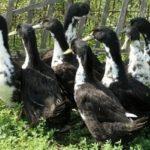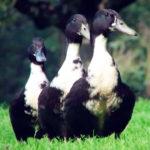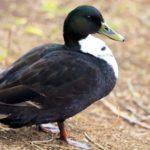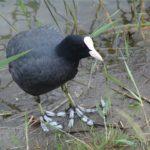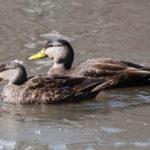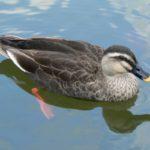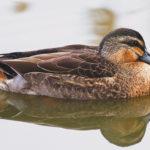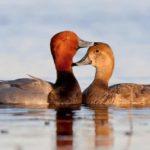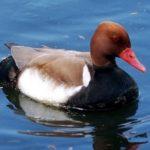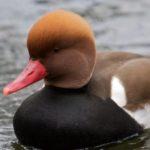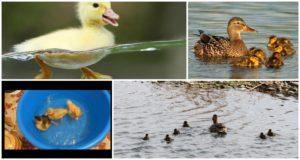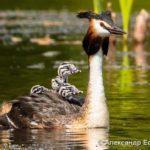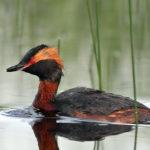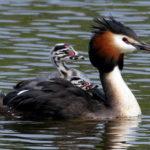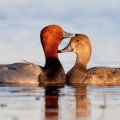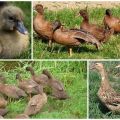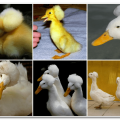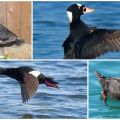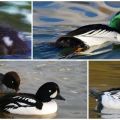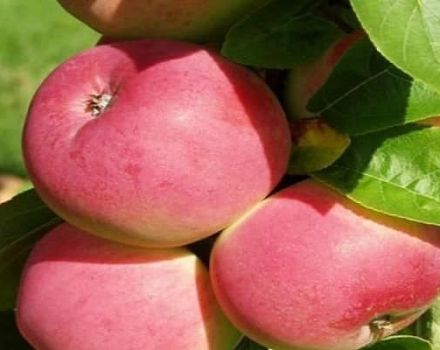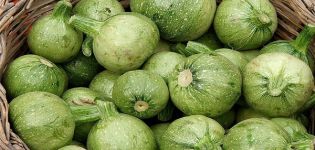Names and 5 varieties of black ducks, which one is better to choose and how to keep
The most common domestic duck with dark plumage is the white-breasted meat type. Due to its high productivity and unpretentiousness, the black duck is considered one of the best varieties for growing in a private backyard. There are also wild species with dark plumage, they can be tamed, but it is impractical. Due to the low meat and egg productivity, wild duck can only be used as an ornamental species.
Features:
Of the wild species with black plumage, the coot duck with a white spot on its forehead is the most common. A wild bird differs from a domestic white-breasted relative in a small body, strong lower limbs and a desire to spend more time out of water. The white-breasted duck is bred by breeding, is characterized by rapid weight gain, gives dietary meat. Three breeds were used in breeding work: Peking, Ukrainian and Khaki Campbell. The duck is distinguished by early maturity, rapid maturation, high egg production, and large egg weight.
White-breasted duck provides not only meat and eggs, its feather is used for the production of bedding. The breed is suitable for breeding work aimed at increasing fertility and meat productivity.
The rest of the wild black species are easy to tame. But poultry farmers do not see this as necessary. Wild duck weighs a little, gives a small number of medium-sized eggs, so its keeping is unprofitable.
But some amateur poultry breeders breed wild waterfowl with black plumage for decorative purposes.
Varieties of black ducks
Each species has individual features of appearance and behavior that determine the use of the bird for decorative or industrial purposes. In order not to be mistaken with the choice, you should consider what it looks like, how productive the duck of each variety is.

Black white-breasted
Large early maturing duck. By 2 months of age, it weighs 2 kg. The weight of an adult reaches 5 kg. Slaughter for meat is carried out for 60-65 days. Laying hens are kept for 2-3 seasons. Drakes are colored brighter than females, their plumage is greenish-purple, and their legs are closer to each other.
The external features and productive qualities of the black white-breasted breed are shown in the table.
| The size | 35-40 cm |
| Weight | 3-5 kg |
| Egg production | 120-160 eggs weighing 80-100 g per season |
| Color | solid black, with a blurry white spot on the neck and chest; eyes, beak, black paws |
| Body type | large oval body, small head, medium-length neck, short wings, not spreading, short tail |
Coot
The wild black duck, belonging to the shepherd family, has an unusual constitution: the legs are disproportionate to the body, large, with long toes. Other names of the species are "kashkaldak", "black white-billed duck". The plumage is solid black, the beak and forehead are white, the iris of the eyes is red, the paws are orange with gray toes. An adult weighs 1.5 kg, grows up to 40 cm.
Sexual differences are not expressed. You can distinguish a female from a drake only by her voice, her voice is more loud and sonorous. The duck makes 2-3 clutches per season, each containing up to 12 greenish-brown eggs. After 3 weeks, ducklings hatch, which quickly become independent, after half a month they themselves get food.
Mallard
The progenitor of all domestic breeds. The female is brown in color with a brown-gray belly. The drake has a green head and neck, the chest is dark brown, the back and belly are speckled gray. During the moulting period, the male becomes black with a brown tint. Body length - 60 cm, weight - about 2 kg.
The mallard, if not migrating, spends the winter in an unfrozen water body. The nest is arranged on the wooded or covered with tall grassy vegetation banks of reservoirs. Reaches sexual maturity by the age of one. Lays up to 13 olive-colored eggs in late spring. A month later, chicks appear, which, as soon as the body dries, immediately show independence.
A relative of the mallard is the African black duck that lives south of the Sahara. Its plumage is black with white spots on the tail and back, and in females it is more saturated.
Red-headed duck
Small wild duck. Length - up to 50 cm, weight - no more than 1.3 kg. The male's head and neck are brick-red, the back is gray, the body is black, the iris is red, and the beak is gray-black. The female is colored more modestly, the head and body are light brown. Voice - quiet whistling and wheezing. When walking, the duck waddles due to the legs set back, but it swims and dives perfectly, it can stay under water for up to 20 seconds.
The duck does not always spend the winter in warm regions; it can remain on an unfrozen pond. The nest is arranged in thickets of high near-water vegetation. 8-10 bluish-green eggs hatch. After 23-25 days, ducklings appear, which become ready for flight after 2 months.
Gray-cheeked grebe
A compact duck with a straight yellow beak, a long red neck and a small head decorated with a black crest. The main color is black with a brown tint. The iris is reddish brown. The duck weighs up to 1 kg, body length is 40 cm. The species is rare, was almost exterminated by poachers, and is gradually recovering.
Selection rules
When choosing birds, take into account the goal of home breeding, the whimsicality and productivity of the species. Almost all wild black species can be domesticated, but productivity is poor, weight gain is weak. Therefore, the wild blackie is not interesting to poultry farmers.
For meat and egg production, an exceptionally large black duck with a white breast is suitable, which is appreciated for its rapid weight gain. The African black mallard lives well in captivity, it is unpretentious in care and nutrition. The coot is an untamed duck, it can fly away at any moment. When buying ducklings for breeding, pay attention to their appearance. Birds should be healthy, mobile, free of anatomical defects and bald spots on the body.

How do they contain?
Adequate space is required to keep birds. 1 m2 the house should have no more than 3 individuals. The floor in the duck dwelling is made of wood, straw or sawdust is used as bedding, laid with a layer of 20 cm, and regularly changed. The optimum summer temperature in the house is 16-18 ° C, winter temperature is 14-16 ° C. Air humidity - 60-70%.
They feed the birds according to the regime, every day at the same time. A standard duck diet consists of:
- grains;
- bran;
- garden greens, vegetables;
- algae;
- bone and fish meal;
- chopped fish;
- sources of minerals - chalk, shell rock, eggshell;
- vitamin supplements.
A fenced area for walking will be organized near the poultry house. If there is no natural reservoir nearby, then a large basin of water is placed in the corral. At night, the birds are closed in the house.
